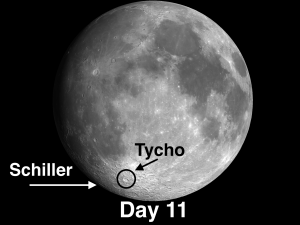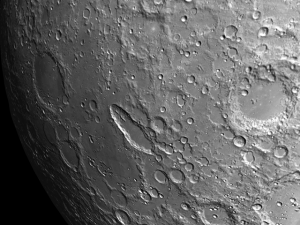 The week of July 3 – 9 takes us from Lunar Day 10 through Day 15 essentially full moon. This week we will highlight the crater Schiller, visible on Tuesday evening, Day 11.
The week of July 3 – 9 takes us from Lunar Day 10 through Day 15 essentially full moon. This week we will highlight the crater Schiller, visible on Tuesday evening, Day 11.
Schiller: [SW/Q6] Schiller is a curiosity. It has the appearance of an unusually elongated crater, but there is no process that could create one crater with such an extremely elongated axis; however, there is no indication on the floor of separate impacts. The current belief is that Schiller was created when a flight of three or four projectiles  landed at virtually the same moment. The liquefied target zones then blended together to leave no trace of separate impacts.
landed at virtually the same moment. The liquefied target zones then blended together to leave no trace of separate impacts.
Just to the southwest of Schiller there is an unnamed basin which shows striations from lunar material that was  blasted out of the Orientale basin located just around the southwest limb of the Moon in the L-M libration zone on your Field Map. (You may have to wait until tomorrow night to see it more clearly.)
blasted out of the Orientale basin located just around the southwest limb of the Moon in the L-M libration zone on your Field Map. (You may have to wait until tomorrow night to see it more clearly.)
UPDATED INFORMATION ON WHAT’S HOT ON THE MOON TONIGHT?
 For those of you who are new to this blog, the author has written a book on observing the Moon entitled What’s Hot on the Moon Tonight? The Ultimate Guide to Lunar Observing. It is a nightly guide to the Moon’s most interesting features as they are revealed throughout the lunar month.
For those of you who are new to this blog, the author has written a book on observing the Moon entitled What’s Hot on the Moon Tonight? The Ultimate Guide to Lunar Observing. It is a nightly guide to the Moon’s most interesting features as they are revealed throughout the lunar month.
I was fortunate in that Charles Wood, author of The Modern Moon: A Personal View, a writer for Sky & Telescope, and the country’s leading authority on lunar observing, was willing to write the foreword. The book is available on Amazon and from my website, AndrewPlanck.com. (If you would like a signed copy, please order from my website.)
UPDATE: An e-book version is now out and is available on iTunes, Amazon Kindle, and other venues. As most of you are aware, lunar features that are described in the book are keyed to the grid in Sky & Telescope’s Field Map of the Moon. In addition, the longitude of lunar features has now been added to the grid reference (e.g., Plato: [NW/D9; L=9°W], meaning open the Field Map to the NW quadrant, grid D9, Plato is at longitude 9°W.)
The longitude of a feature can be enormously helpful when you are planning a night’s observation. Any object which is within 15° or so of the terminator will stand out with astonishing detail1!
1To find out what the longitude of the terminator will be for any night, download the free Virtual Moon Atlas onto your computer. Set the date to when you wish to observe, then click on a crater on the terminator and read its longitude. Or use the Moon Map Pro app if you are lucky enough to have gotten it before it became unavailable on iTunes.
======================
It is highly recommended that you get a copy of Sky and Telescope’s Field Map of the Moon, the very finest Moon map available for use at the telescope. It is available for $10.95 at www.skyandtelescope.com and on Amazon. All features mentioned in this blog will be keyed to the grid on the Field Map and will look like this: Plato: [NW/D9]
Credits:
Courtesy of Gray Photography of Corpus Christi, Texas
Lunar photos: NASA / USGS / BMDO / LROC / ASU / DLR / LOLA / Moon Globe. Used by permission
- Rupes Cauchy: A Best Known Fault on the Moon - July 22, 2024
- Moon Crater Schickard – Crater Floor has Stripes - July 15, 2024
- Moon Craters Langrenus and Vandelinus - July 8, 2024